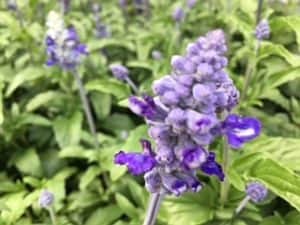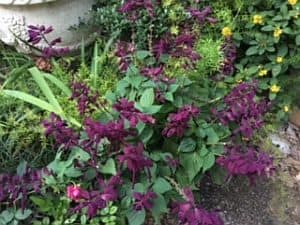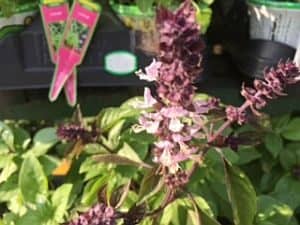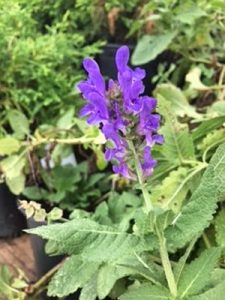
Salvia
Salvia officinalis is a member of the Lamiaceae family. Salvia is the largest genus of the mint family. The genus Salvia is collectively referred to as Sage. Some serve as annual bedding plants and others are border perennials, and still others are shrubs, culinary herbs, or ground covers. Salvias look great in containers as single specimens or with other plants. In cold temperature areas, salvias are grown as annuals or tender perennials and shrubs. Well drained soils can be the key to their survival through the winter.
All sages have square stems and whorls of two-lipped flowers, either neatly spaced along the flower stalks or tightly crowded and densely and look like a spike. Some have branched inflorescences. The flower colors are white and yellow to salmon, pink, scarlet, red lavender, blue and dark purple. A few have fragrant blooms, most have aromatic foliage. The aromatic foliage makes them resistant to deer and rabbits. The nectar rich flowers attract pollinators such as honey bees, native bees, butterflies and hummingbirds.
![]()
Salvia leucantha is the Mexican bush sage and is one of the best fall flowering perennial salvias for Louisiana. This one was grown before other varieties became more popular. These are hardy and come back from previous years plantings. Flowers are mostly purple with some white ones and purple and white bi-color. Blooms late summer to frost. Plants reach 4-5 feet by fall when planted in spring.
Mealycup sage, also known as blue salvia, is a native wildflower of Texas is well adapted to hot summers. Cultivars of the species are tough like the original wildflower and have been popular in Louisiana landscapes for many years. Victoria mealycup sage is popular in bedding plants, found in local nurseries that produce dark blue flowers .

Evolution salvia was named Louisiana Super Plant for spring 2016. It is a cultivar of mealycup sage (Salvia farinacea) and comes in two colors. Salvia Evolution Violet and Salvia Evolution White. They have been proved exceptional performance and have unique coloring.
Salvia Splendens is the scarlet salvia or annual salvia which has red spikes. It blooms in Summer and fall. The blooms are scarlet, red, burgundy, purple, lilac, white pink, peach and lavender. Fertilizer every 6 to 8 weeks. Plant 8 inches apart in well-drained soil.
Salvia need full sun for maximum flowering but can tolerate. Flowering decreases during the intense heat of summer but resumes in fall. When preparing the bed, turn soil about 8 inches and add about 4 inches of organic matter with a general purpose fertilizer. Incorporate all matter thoroughly. Space plants about 12 to 14 inches apart then mulch bed. Water appropriately once newly planted. Do not water excessively during summer to avoid root rot and diseases. Under the right conditions salvia have few major insects and diseases.
Submitted by Karen Blackburn




